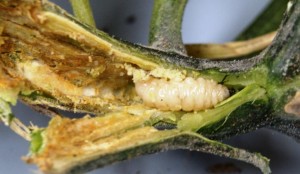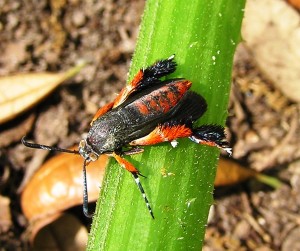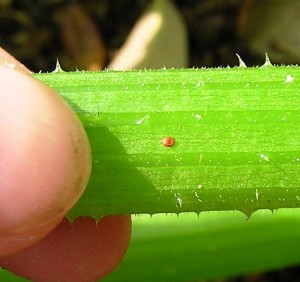Why is my squash wilting? Assuming you have been giving your vegetable garden adequate water, the Squah Vine Borer may be the cause.
Unfortunately presence of the squash vine borer, the larval form of a clearwing moth, is usually noticed only after damage is permanent. Prevention is possible with early recognition through vigilant scouting.
The adult moth is common in gardens throughout Northwest Florida, and is easily recognizable due to its black and orange coloration.The 1/2 inch moth is active during the day and will lay a single tiny orange egg at the base of healthy squash plants.
It only takes a week for the egg to hatch and for the larva to bore into the stem. Once the larva in inside the stem, it chews its way up the stem, blocking the transport of water from the roots to the shoots. By the time wilting is noticed, total blockage of the water conducting tissue (Xylem) is likely.
If the moth is noticed in the garden, preventitive application of Bt (Bacillus thuringiensis) or pyrethroid (permethrin or bifenthrin) insecticide to the base of the stem may stop their incursion into the vine. Yellow traps full of water can be put out to monitor for them, since they are attracted to anything yellow.
If the vine is already affected, insecticide applications will not help. There is a slim chance of saving it by cutting out the larva. While performing this task make sure to preserve the stem and bury the stem of the plant in a few inches of protective soil. The plant may grow new roots and resume production.
For more information about the Squash Vine Borer, proceed to this University of Kentucky article. To learn more about pests of Cucurbits, check out this informative UF / IFAS publication, Insects Management for Cucurbits.
- Woodland Pinkroot Adds Vibrant Color to Spring Landscapes - April 27, 2023
- Easy Care Roses for the Gulf South - April 20, 2023
- Herb Gardening: When Oregano is Flavorless - March 9, 2023



